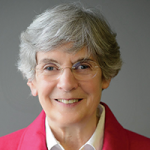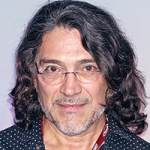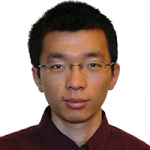Data Is My Job: Four ASA Members Share Career Insights
Career opportunities are limitless with a degree in statistics or data science. To celebrate Mathematics and Statistics Awareness Month (#mathaware), we highlight four ASA members who have used their statistics skills and imaginations to snag sweet jobs.
 Janet McDougall is the founder and president of McDougall Scientific consulting firm.
Janet McDougall is the founder and president of McDougall Scientific consulting firm.
 Rob Santos is the chief methodologist and director of the Statistical Methods Group at the Urban Institute.
Rob Santos is the chief methodologist and director of the Statistical Methods Group at the Urban Institute.
 Yihui Xie is a data scientist and software engineer at RStudio, Inc.
Yihui Xie is a data scientist and software engineer at RStudio, Inc.
 Nancy Potok is the chief statistician of the United States.
Nancy Potok is the chief statistician of the United States.
What do you during a typical day at work?
McDougall: Like most professionals/managers, there is not really a typical day, but there are tasks you regularly perform. I balance managing the company with keeping up as a statistician and working with clients.
Email. Updates on ongoing projects (sometimes resolving issues); answering clients’ questions; reaching out to potential clients or collaborators; setting up meetings; keeping up on industry changes, regulations, and statistics by being on mailing lists and reviewing the content
Meetings. Both internal—project management, product development, finance, HR, marketing—and external—going to meet with clients offsite or having teleconferences with them
Research. New statistical methods, therapeutic areas, regulations—usually as part of a project or a work-up for bidding on the project
Training. Finding, organizing, and attending webinars in statistics, data management, etc.; also having statistical discussions with staff about design and analysis issues
The one big omission is programming. I don’t meet our standards for a programmer—because of all the other distractions—and I do miss that part of the job.
Santos: On any given day, I will be overseeing policy research projects in diverse topics like housing discrimination, refugee resettlement, urban community attachment, food insecurity, driving travel behavior, client feedback loops, and firefighter safety and risk assessment, as well as attending to internal administrative projects like IRB reviews, advancing diversity/inclusion and community engagement research methods, and chairing institutional awards committee deliberations (this is but a portion of my current portfolio).
Xie: I answer software questions from various channels (StackOverflow, GitHub, emails, etc.) and write code, documentation, and books. I have been trying to publish one book a year since 2015, and—this year—I’m working on my fourth book.
Potok: There is no typical day—every day is different. A lot of my job involves external relationships with stakeholders, data users, and the US statistical agencies. As a result, I may be out of my office for the greater part of the day meeting with people, speaking at conferences or other events, attending workshops, or strategizing with the statistical agency heads on our priority work areas. On other days, I am mostly in my office meeting with my small staff and guiding their activities. Some days, I brief the policy officials at the Office of Management and Budget on high-priority decisions that need to be made or documents that need to be cleared. If I am really lucky, I get to catch up on things I should be reading once in a while.
We want to see you sharing your cool data jobs with future statisticians and data scientists. Snap a selfie with our #CelebrateStatistics or #CelebrateDataScience printable posters, post them on social media, and tag @AmstatNews. Print the main poster too!
How did you end up in your current position?
McDougall: By chance. I started freelance work in the pharmaceutical industry after working at one company for about four years. Through contacts in the industry, the workload grew and I brought others onboard, then had to move the business out of my home and into a leased office. Taking on leases, it seemed appropriate to incorporate—so I did and, as the owner, became the de facto president.
For the next couple of years, I kept my title as statistician, as that was what I was proud to be. When a future client asked if this was my father’s business, I recognized I had to take the business—and my image—more seriously and adopted the title of president. I kept the title and have grown into the position, learning to be more of a strategic thinker and planner, making important and tough decisions, mentoring, delegating—even my beloved programming—to the growing staff, dealing with all the financial administrative tasks.
I was lucky to find good business coaches along the way who not only guided me, but also two other staff members (also statisticians) to form a management team. My role as senior statistician, where I keep abreast of the developing statistical trends and advise on design and analysis, is still what gives me the greatest pleasure.
Santos: Through a journey-pursuing opportunity. I spent much of my career in leadership positions trying to promote the most rigorous research in university-based survey research centers at Temple University, University of Michigan, and The University of Chicago. I finally realized I wanted to be closer to the action of putting research results to use for the betterment of society and landed at the Urban Institute, a public policy research think tank.
I then was lured back to my home state of Texas (Austin) to co-own a social science research firm, but we sold the firm after six years of amazing growth and interesting projects.
And then I returned to Urban Institute to resume my passion for conducting research for the public good. And this is where I have been the past 11 years.
I enjoy most the ability to play in everyone’s tent, be it justice policy, immigration, housing, hunger issues, health, education, infrastructure, program evaluation, you name it. The past decade has been the most rewarding and fulfilling period career-wise in my life.
Xie: I wrote an R package named “knitr” in late 2011, which caught the attention of our current CEO. I met him in 2012 for the first time and collaborated on a few talks, including a keynote at the useR! conference in 2012. We had a brief phone call in 2013, when I was about to look for a job. He basically said “Yes,” and that’s it.
I’m a statistician by training, but I love programming more than statistics. Sorry! I probably should not have said that here. Anyway, I write software primarily for statisticians and data analysts.
Potok: The short, technically correct answer is that I applied for it on USAJobs.com and was selected through the federal government’s merit selection process. Of course, that was after a long and varied career that spanned two tours at the US Census Bureau (first as the principal associate director and CFO and the second as the deputy director and COO); working in the private sector doing social science research and consulting; and—at various times—holding other federal positions, including deputy undersecretary for economic affairs at the Department of Commerce. I discovered I had a real passion for strategically managing data and the people who create and disseminate data to inform major policy questions and provide high-quality information that could change peoples’ lives for the better.
What did you want to be when you were 12?
McDougall: A scientist. I got my first chemistry set when I was around eight or nine years old and loved the sense of wonder and discovery.
Santos: I totally wanted to be a math professor. I loved everything there was about mathematics and majored in math for my BA. But when it came time to think about graduate school, my counseling professor insisted I consider a more applied area—statistics—so I could always have a great job. Time has shown he certainly steered me well.
Xie: I just wanted to study super hard and obtain the highest possible educational degree, which was a “postdoc” according to what people in my village told me when I was a boy. I probably also wanted to be a scientist. Now some people call me “data scientist,” which is not what I intended to be when I was 12; I had no clue about statistics until I went to college. To a child, a scientist who plays with colorful chemicals looks like more fun. Playing with data is also fun, although it is a little more abstract.
Potok: My career goal at age 12 was to be a librarian. I loved reading, doing research, and uncovering new and interesting information. One of my favorite activities at that age was to pick up a Funk & Wagnalls encyclopedia, open it to a random page, and just start reading. Of course, at age 13, I discovered boys and my career ambition shifted quickly to wanting to be a go-go dancer for a rock band. It’s been an interesting ride since then.
What career advice would you give your 20-year-old self?
McDougall: Keep learning—and not just in your narrow discipline. I still over-prepare for meetings and discussions about protocol development and analyses—therapeutic areas, publications for the disease or the design—also just general trends in our society. By reading widely, the doors to serendipity open more frequently and you get wonderful insights into a problem or an opportunity that you might miss otherwise. You ‘see’ things other people miss, because your mind has been opened to different possibilities.
Santos: I’d say pursue your passions, keep your options open, have fun, and always challenge yourself beyond your self-perceived limitations. Life’s all about the journey, not the destination. A great career and a good, fulfilling life can be had by heeding those few words.
Xie: Try more often to do things you don’t like but are important at the same time. It is easy to do things you like, but in the real world, there is no guarantee you will like all tasks assigned to you. Don’t be afraid of the pain from challenges. If you don’t feel the pain in tackling a challenge, it basically means you are losing the chance to learn more things and grow up.
Potok: Conquer your fear of taking big risks to follow your dreams—at 20 years old, there is plenty of time to learn from your mistakes and discover both what you are great at and what makes you happy.










 (1 votes, average: 4.00 out of 5)
(1 votes, average: 4.00 out of 5)






